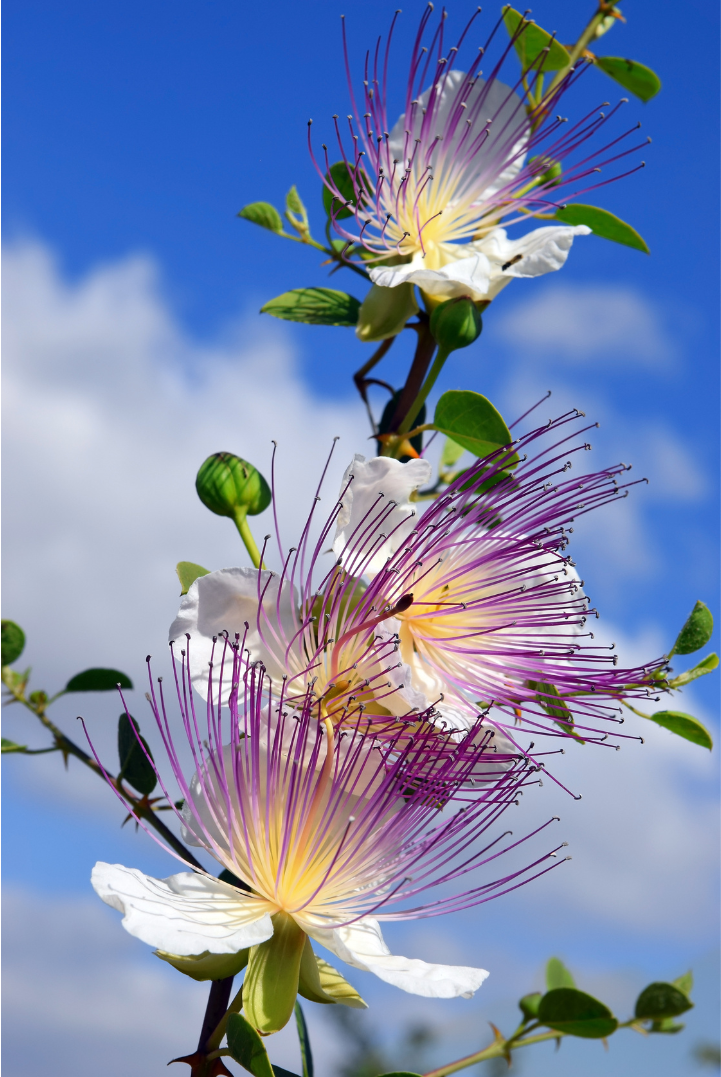Menorca is home to a surprising amount of potent wild culinary plants. Each month of the year gifts us with something wonderful that is in season. One of the delicacies of June is the harvesting of wild capers.
Caper plants or ‘Tàperes’ as they are called in Menorquin, seem to grow everywhere on the island: On cliff faces, on the sandstone walls of the old port in Ciutadella, on sidewalks of the suburbs around the coast, they even pop up in gardens, anywhere with limestone is favourable. Once you recognise the plant you will be able to see it in abundance all over the place!
So for the curious, here is all you may want to know about Menorcan Capers!
Seasonality and Growth Locations
Capers flourish during the warm months on Menorca, typically from late spring to early autumn. They are mostly to be found growing abundantly along the island’s rocky coastal cliffs, nestled among the native flora. The combination of Menorca’s Mediterranean climate and limestone-rich soil creates an ideal environment for the caper plant’s growth.
Picking and Storag
Harvesting capers is a meticulous process that requires patience and attention to detail. The plant is flowering towards the end of Spring as the season shifts into Summer. An attractive and unusual flowering bush, the capers are the bud of the flower so must be picked at just the right time by hand before they fully bloom, ensuring optimal taste and texture. The flowers have white petals and fuschia pink stalks, quite beautiful when the plant is in full bloom.
At this time of year, you can frequently see locals collecting buds from the plants on the rocks of the coastline, however, I wouldn’t recommend it yourself if you don’t know exactly when to pick them or what to do with them. Respecting the autonomous flora of the island and its growth cycles helps to preserve its regeneration for many years to come.
Technically, capers can be eaten raw but normally they are preserved in jars to be consumed at a later date. Some say it’s necessary to wash them first, but others preserve them without washing them to conserve their natural saltiness as much as possible. After picking, capers are soaked in water or vinegar to remove the bitterness. They are then carefully dried and packed into jars, preserving their unique flavour and versatility for later use.
Health Properties
Beyond their distinctive flavour, capers offer an array of health benefits. These small flower buds are rich in antioxidants, vitamins A and K, and minerals such as iron and calcium. Antioxidants help protect against cell damage, while vitamins and minerals support various bodily functions, including bone health and iron absorption. Every little bit helps right? Even if its a few small flavour enhancers, they are potent indeed.
Culinary Traditions
Capers are a less common ingredient of Menorcan cuisine. I was never much of a caper fan myself before I moved here, truthfully I would pick them out of my favourite salmon and cream cheese appetisers, yet I have come to love a few capers in vinegar tossed to a mixed salad.
Summer Salads & Pasta: We always have a jar of capers in the fridge for any salad. They can be tossed into green salads for a burst of tanginess or sprinkled over pasta with fresh herbs and a drizzle of olive oil for a delightful Mediterranean twist.
When tomatoes are in season in July, adding capers to a fresh tomato salad with or without mozzarella is a special summer treat I look forward to every year. I’m counting down the days till tomato season as we speak!
Menorcan Mayonnaise: A beloved condiment said to have originated on the island, a twist on the original recipe incorporates capers into this creamy, tangy sauce. To enjoy as a dip for vegetables, a spread for sandwiches, or a topping for grilled meats and seafood.
‘Llengua amb tàperes’: For the more adventurous, the most typical Menorcan dish using capers is called ‘Tongue with Capers’. Consisting of beef tongue, vegetables, herbs, garlic, stock and capers, this is a local delicacy served as tapas with bread, or on a roll and is a tasty soft meat in-sauce dish still very popular in the most traditional bars around the island.
I’m curious to know in the comments, are you a fan of Capers or not, if so how do you eat them?
Where have you spotted the plants around the island?











